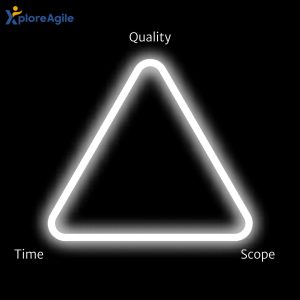Menu

As a project manager, one of the most challenging aspects of your job is balancing the various constraints of managing a project. In particular, you must ensure the project is delivered on time, within budget, and to the required quality standards. This is where the Agile Iron Triangle comes into play. This post will explore the Agile Iron Triangle and how it relates to project management.
The Agile Iron Triangle is a framework that outlines the relationship between three key constraints in project management: quality, time, and scope. It is called the “iron triangle” because these three factors are interdependent and cannot be changed without affecting the others. The Agile Iron Triangle differs from the traditional Iron Triangle because it considers the Agile methodology’s iterative and incremental approach.
The Agile Iron Triangle is illustrated in the diagram below:

Quality measures how well a product or service meets the customer’s requirements. It is one of the most critical factors in project management because it ultimately determines whether the project succeeds or fails. Here are some key points to consider when it comes to quality:
Time measures how long it takes to complete a project or deliver a product or service. It is another critical factor in project management because time constraints can significantly impact a project’s success. Here are some key points to consider when it comes to time:
The scope measures the work required to complete a project or deliver a product or service. It is another critical factor in project management because scope creep can significantly impact a project’s success. Here are some key points to consider when it comes to scope:
The Agile Iron Triangle factors are interdependent, meaning that changes to one factor will affect the other. For example, the time and quality may be impacted if the scope increases. Similarly, the scope and quality may be impacted if the time decreases. Here are some examples:
The Agile Iron Triangle can be used to help project managers balance the various constraints of managing a project. Here are some key points to consider:
The Agile Iron Triangle is a powerful framework that can help project managers balance the various project management constraints. By understanding the relationship between quality, time, and scope, project managers can make informed decisions that will help to ensure the project’s success. By using Agile methodologies and involving stakeholders in the process, project managers can help to mitigate potential conflicts and ensure that everyone is working towards the same end goal.


Over the last three months, I have had the opportunity to collaborate with David and test his Situational courses. It has been an exceptional experience with numerous practical lessons and enjoyable discussions. I strongly endorse his training techniques and the courses he provides.

Senior Manager
xploreAgile (XA) are passionate
providers of Agile Consulting,
Coaching and Training Services
VAT Registration Number: GB 332 3136 42
Copyright by XploreAgile. All rights reserved.

Joe Doe in London, England purchased a

